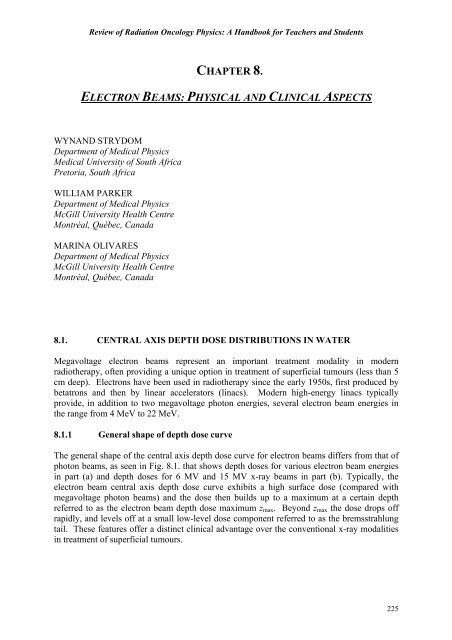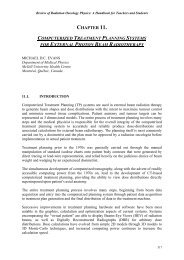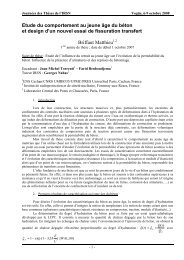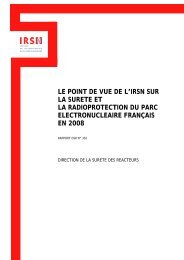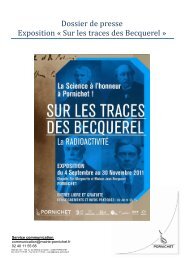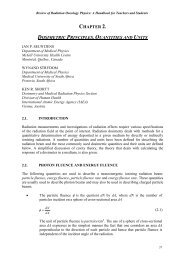chapter 8. electron beams: physical and clinical aspects - IRSN
chapter 8. electron beams: physical and clinical aspects - IRSN
chapter 8. electron beams: physical and clinical aspects - IRSN
Create successful ePaper yourself
Turn your PDF publications into a flip-book with our unique Google optimized e-Paper software.
Review of Radiation Oncology Physics: A H<strong>and</strong>book for Teachers <strong>and</strong> Students<br />
CHAPTER <strong>8.</strong><br />
ELECTRON BEAMS: PHYSICAL AND CLINICAL ASPECTS<br />
WYNAND STRYDOM<br />
Department of Medical Physics<br />
Medical University of South Africa<br />
Pretoria, South Africa<br />
WILLIAM PARKER<br />
Department of Medical Physics<br />
McGill University Health Centre<br />
Montréal, Québec, Canada<br />
MARINA OLIVARES<br />
Department of Medical Physics<br />
McGill University Health Centre<br />
Montréal, Québec, Canada<br />
<strong>8.</strong>1. CENTRAL AXIS DEPTH DOSE DISTRIBUTIONS IN WATER<br />
Megavoltage <strong>electron</strong> <strong>beams</strong> represent an important treatment modality in modern<br />
radiotherapy, often providing a unique option in treatment of superficial tumours (less than 5<br />
cm deep). Electrons have been used in radiotherapy since the early 1950s, first produced by<br />
betatrons <strong>and</strong> then by linear accelerators (linacs). Modern high-energy linacs typically<br />
provide, in addition to two megavoltage photon energies, several <strong>electron</strong> beam energies in<br />
the range from 4 MeV to 22 MeV.<br />
<strong>8.</strong>1.1 General shape of depth dose curve<br />
The general shape of the central axis depth dose curve for <strong>electron</strong> <strong>beams</strong> differs from that of<br />
photon <strong>beams</strong>, as seen in Fig. <strong>8.</strong>1. that shows depth doses for various <strong>electron</strong> beam energies<br />
in part (a) <strong>and</strong> depth doses for 6 MV <strong>and</strong> 15 MV x-ray <strong>beams</strong> in part (b). Typically, the<br />
<strong>electron</strong> beam central axis depth dose curve exhibits a high surface dose (compared with<br />
megavoltage photon <strong>beams</strong>) <strong>and</strong> the dose then builds up to a maximum at a certain depth<br />
referred to as the <strong>electron</strong> beam depth dose maximum z max . Beyond z max the dose drops off<br />
rapidly, <strong>and</strong> levels off at a small low-level dose component referred to as the bremsstrahlung<br />
tail. These features offer a distinct <strong>clinical</strong> advantage over the conventional x-ray modalities<br />
in treatment of superficial tumours.<br />
225
Chapter <strong>8.</strong> Electron Beams: Physical <strong>and</strong> Clinical Aspects<br />
FIG. <strong>8.</strong>1. Typical central axis percentage depth dose curves in water for a 10 x 10 cm 2 field<br />
size <strong>and</strong> an SSD of 100 cm for (a) <strong>electron</strong> <strong>beams</strong> with energies of 6,9,12 <strong>and</strong> 18 MeV <strong>and</strong> (b)<br />
photon <strong>beams</strong> with energies of 6 MV <strong>and</strong> 15 MV.<br />
• A typical high energy linear accelerator may produce several <strong>electron</strong> <strong>beams</strong> with<br />
discrete energies in the range from 4 MeV to 25 MeV.<br />
• Electron <strong>beams</strong> can be considered almost mono-energetic as they leave the<br />
accelerator; however, as the <strong>electron</strong> beam passes through the linac exit window,<br />
monitor chambers, collimators <strong>and</strong> air, the <strong>electron</strong>s interact with these structures<br />
resulting in:<br />
- broadening of the beam’s <strong>electron</strong> energy spectrum.<br />
- bremsstrahlung production contributing to the bremsstrahlung tail in the<br />
<strong>electron</strong> beam PDD distribution.<br />
• On initial contact with the patient, the <strong>clinical</strong> <strong>electron</strong> beam has an incident mean<br />
energy E that is lower than the <strong>electron</strong> energy inside the accelerator.<br />
o<br />
• The ratio of the dose at a given point on the central axis of an <strong>electron</strong> beam to the<br />
maximum dose on the central axis multiplied by 100 is the percentage depth dose<br />
(PDD). The percentage depth dose is normally measured for the nominal<br />
treatment distance <strong>and</strong> depends on field size <strong>and</strong> <strong>electron</strong> beam energy.<br />
<strong>8.</strong>1.2. Electron interactions with absorbing medium<br />
• As <strong>electron</strong>s travel through a medium, they interact with atoms by a variety of<br />
Coulomb force interactions that may be classified as follows:<br />
(a) inelastic collisions with atomic <strong>electron</strong>s resulting in ionisation <strong>and</strong><br />
excitation of atoms <strong>and</strong> termed collisional or ionisational loss;<br />
(b) inelastic collisions with nuclei resulting in bremsstrahlung production <strong>and</strong><br />
termed radiative loss;<br />
(c) elastic collisions with atomic <strong>electron</strong>s; <strong>and</strong><br />
(d) elastic collisions with atomic nuclei resulting in elastic scattering which is<br />
characterized by change in direction but no energy loss.<br />
226
Review of Radiation Oncology Physics: A H<strong>and</strong>book for Teachers <strong>and</strong> Students<br />
• The kinetic energy of <strong>electron</strong>s is lost in inelastic collisions that produce<br />
ionisation or is converted to other forms of energy, such as photon energy or<br />
excitation energy. In elastic collisions kinetic energy is not lost; however, the<br />
<strong>electron</strong>’s direction may be changed or the energy may be redistributed among the<br />
particles emerging from the collision.<br />
• The typical energy loss in tissue for a therapy <strong>electron</strong> beam, averaged over its<br />
entire range, is about 2 MeV⋅ cm 2 /g .<br />
• The rate of energy loss for collisional interactions depends on the <strong>electron</strong> energy<br />
<strong>and</strong> on the <strong>electron</strong> density of the medium. The rate of energy loss per gram per<br />
centimeter squared (called the mass stopping power) is greater for low atomic<br />
number materials than for high atomic number materials. This is because the high<br />
atomic number material has fewer <strong>electron</strong>s per gram than the lower atomic<br />
number material <strong>and</strong>, moreover, high atomic number materials have a larger<br />
number of tightly bound <strong>electron</strong>s that are not available for this type of<br />
interaction.<br />
• The rate of energy loss for radiative interactions (bremsstrahlung) is approximately<br />
proportional to the <strong>electron</strong> energy <strong>and</strong> to the square of the atomic<br />
number of the absorber. This means that x-ray production through radiative losses<br />
is more efficient for higher energy <strong>electron</strong>s <strong>and</strong> higher atomic number materials.<br />
• When a beam of <strong>electron</strong>s passes through a medium, the <strong>electron</strong>s suffer multiple<br />
scattering due to Coulomb force interactions between the incident <strong>electron</strong>s <strong>and</strong><br />
predominantly the nuclei of the medium. The <strong>electron</strong>s will therefore acquire<br />
velocity components <strong>and</strong> displacements transverse to their original direction of<br />
motion. As the <strong>electron</strong> beam traverses the patient, its mean energy decreases <strong>and</strong><br />
its angular spread increases.<br />
• The scattering power of <strong>electron</strong>s varies approximately as the square of the atomic<br />
number <strong>and</strong> inversely as the square of the kinetic energy. For this reason high<br />
atomic number materials are used in the construction of scattering foils that are<br />
used for the production of <strong>clinical</strong> <strong>electron</strong> <strong>beams</strong> in a linear accelerator.<br />
<strong>8.</strong>1.3 Inverse square law (virtual source position)<br />
In contrast to a photon beam, which has a distinct focus located at the linac x-ray target, the<br />
<strong>electron</strong> beam appears to originate from a point in space that does not coincide with the<br />
scattering foil or the accelerator exit window. The term virtual source position was introduced<br />
to indicate the virtual location of the <strong>electron</strong> source.<br />
• The effective SSD for <strong>electron</strong> <strong>beams</strong> (SSD eff ) is defined as the distance from the<br />
virtual source position to the point of nominal SSD (usually the isocentre of the<br />
linac). The inverse square law may be used for small SSD differences from the<br />
nominal SSD to make corrections to the absorbed dose for variations in air gaps<br />
between the patient surface <strong>and</strong> the applicator.<br />
227
Chapter <strong>8.</strong> Electron Beams: Physical <strong>and</strong> Clinical Aspects<br />
• There are various methods to determine the SSD eff . One commonly used method<br />
consists in measuring the output at various distances from the <strong>electron</strong> applicator<br />
by varying the gap between the phantom surface <strong>and</strong> the applicator (with gaps<br />
ranging from 0 to 15 cm). In this method, doses are measured in a phantom at the<br />
depth of maximum dose z max , with the phantom first in contact with the applicator<br />
(zero gap) <strong>and</strong> then at various distances g from the applicator. Suppose I o is the<br />
dose with zero gap (g = 0) <strong>and</strong> I g is the dose with gap distance g. It follows then<br />
from the inverse square law:<br />
2<br />
I ⎛<br />
o<br />
SSDeff + zmax<br />
+ g ⎞<br />
= ⎜<br />
Ig ⎝ SSDeff + z<br />
⎟ , (<strong>8.</strong>1)<br />
max ⎠<br />
or:<br />
Io<br />
g<br />
= + 1<br />
I SSD + z<br />
g eff max<br />
, (<strong>8.</strong>2)<br />
A plot of I<br />
o<br />
/I<br />
g<br />
against the gap distance g will give a straight line with a slope<br />
of<br />
1<br />
SSD + z<br />
eff<br />
max<br />
<strong>and</strong> the SSD eff will then be given by:<br />
SSD<br />
eff<br />
1<br />
= − zmax<br />
. (<strong>8.</strong>3)<br />
slope<br />
• Although the effective SSD is obtained from measurements at z max , its value does<br />
not change with depth of measurement. However, the effective SSD changes with<br />
beam energy <strong>and</strong> it has to be measured for all energies available in the clinic.<br />
<strong>8.</strong>1.4 Range concept (csda)<br />
A charged particle such as an <strong>electron</strong> is surrounded by its Coulomb electric force <strong>and</strong> will<br />
therefore interact with one or more <strong>electron</strong>s or with the nucleus of practically every atom it<br />
encounters. Most of these interactions individually transfer only minute fractions of the<br />
incident particle's kinetic energy <strong>and</strong> it is convenient to think of the particle as losing its<br />
kinetic energy gradually <strong>and</strong> continuously in a process often referred to as the continuous<br />
slowing down approximation (csda).<br />
• The path length of a single <strong>electron</strong> is the total distance traveled until the <strong>electron</strong><br />
comes to rest, regardless of the direction of movement.<br />
• The projected path range is the sum of individual path lengths along the incident<br />
direction.<br />
• The csda range (or the mean path-length) for an <strong>electron</strong> of initial kinetic energy<br />
E o can be found by integrating the reciprocal of the total stopping power:<br />
228
Review of Radiation Oncology Physics: A H<strong>and</strong>book for Teachers <strong>and</strong> Students<br />
R<br />
csda<br />
( )<br />
−1<br />
Eo<br />
⎛S E ⎞<br />
= ∫ ⎜ ⎟ dE<br />
0<br />
⎝ ρ<br />
. (<strong>8.</strong>4)<br />
⎠<br />
tot<br />
• The csda range thus represents the mean path-length <strong>and</strong> not the depth of<br />
penetration in a defined direction. The csda range for <strong>electron</strong>s in air <strong>and</strong> water is<br />
given in Table <strong>8.</strong>I. for various <strong>electron</strong> kinetic energies.<br />
• The following two concepts of range are also defined for <strong>electron</strong> <strong>beams</strong>:<br />
(1) Maximum range<br />
(2) Practical range.<br />
• The maximum range R max is defined as the depth at which extrapolation of the tail<br />
of the central-axis depth dose curve meets the bremsstrahlung background, as<br />
shown in Fig. <strong>8.</strong>2. It is the largest penetration depth of <strong>electron</strong>s in the absorbing<br />
medium. The maximum range has the drawback of not giving a well-defined<br />
measurement point.<br />
• The practical range R p is defined as the depth at which the tangent plotted through<br />
the steepest section of the <strong>electron</strong> depth dose curve intersects with the<br />
extrapolation line of the background due to bremsstrahlung, as shown in Fig. <strong>8.</strong>2.<br />
• The depths R 90 <strong>and</strong> R 50 are defined as depths on the <strong>electron</strong> percentage depth<br />
dose curve at which the percentage depth doses beyond z max attain values of 90%<br />
<strong>and</strong> 50%, respectively.<br />
• The depth R q is defined as the depth where the tangent through the dose inflection<br />
point intersects the maximum dose level as shown in Fig. <strong>8.</strong>2.<br />
• It is evident that the csda range is of marginal usefulness in characterizing the<br />
depth of penetration of <strong>electron</strong>s into an absorbing medium. Scattering effects,<br />
both between the incident <strong>electron</strong>s <strong>and</strong> nuclei of the absorbing medium as well as<br />
between the incident <strong>electron</strong>s <strong>and</strong> orbital <strong>electron</strong>s of the absorbing medium,<br />
cause <strong>electron</strong>s to follow very tortuous paths resulting in large variations in actual<br />
penetration of <strong>electron</strong>s into the absorbing medium.<br />
TABLE <strong>8.</strong>I. Csda RANGES IN AIR AND WATER FOR VARIOUS<br />
ELECTRON ENERGIES.<br />
Electron energy<br />
(MeV)<br />
6<br />
7<br />
8<br />
9<br />
10<br />
20<br />
30<br />
Csda range in air<br />
(g/cm 2 )<br />
3.255<br />
3.756<br />
4.246<br />
4.724<br />
5.192<br />
9.447<br />
13.150<br />
Csda range in<br />
water (g/cm 2 )<br />
3.052<br />
3.545<br />
4.030<br />
4.506<br />
4.975<br />
9.320<br />
13.170<br />
229
Chapter <strong>8.</strong> Electron Beams: Physical <strong>and</strong> Clinical Aspects<br />
FIG. <strong>8.</strong>2. Typical <strong>electron</strong> beam percentage depth dose curve illustrating the definition of<br />
R q , R p , R max , R 50 . <strong>and</strong> R 90 .<br />
<strong>8.</strong>1.5. Build-up region (depths between surface <strong>and</strong> z max , i.e., 0 ≤ z ≤ z max )<br />
The dose build-up in <strong>electron</strong> <strong>beams</strong> is much less pronounced than that of megavoltage<br />
photon <strong>beams</strong> <strong>and</strong> results from the scattering interactions that the <strong>electron</strong>s experience with<br />
atoms of the absorber. Upon entry into the medium (e.g., water), the <strong>electron</strong> paths are<br />
approximately parallel. With depth their paths become more oblique with regard to the<br />
original direction due to multiple scattering, resulting in an increase in <strong>electron</strong> fluence along<br />
the beam central axis.<br />
• In the collision process between <strong>electron</strong>s <strong>and</strong> atomic <strong>electron</strong>s, it is possible that<br />
the kinetic energy acquired by the ejected <strong>electron</strong> is large enough (hard collision)<br />
to cause further ionisation. In such a case, these <strong>electron</strong>s are referred to as<br />
secondary <strong>electron</strong>s or delta (∆) rays <strong>and</strong> they also contribute to the build-up of<br />
dose.<br />
• As seen in Fig. <strong>8.</strong>1, the surface dose of <strong>electron</strong> <strong>beams</strong> (in the range from 75 to<br />
95%) is much higher than the surface dose for photon <strong>beams</strong> (< 30%), <strong>and</strong> the rate<br />
at which the dose increases from the surface to z max is therefore less pronounced<br />
for <strong>electron</strong> <strong>beams</strong> than for photon <strong>beams</strong>.<br />
• Unlike in photon <strong>beams</strong>, the percent surface dose for <strong>electron</strong> <strong>beams</strong> increases<br />
with <strong>electron</strong> energy. This can be explained by the nature of <strong>electron</strong> scatter. At<br />
lower energies, the <strong>electron</strong>s are scattered more easily <strong>and</strong> through larger angles.<br />
This causes the dose to build up more rapidly <strong>and</strong> over a shorter distance, as<br />
shown in Fig. <strong>8.</strong>3. The ratio of surface dose to maximum dose is, therefore, lower<br />
for lower-energy <strong>electron</strong>s than for higher-energy <strong>electron</strong>s.<br />
• In contrast to the behaviour of megavoltage photon <strong>beams</strong>, the depth of maximum<br />
dose in <strong>electron</strong> <strong>beams</strong>, z max , does not follow a specific trend with <strong>electron</strong> beam<br />
energy, rather it is a result of machine design <strong>and</strong> accessories used.<br />
230
Review of Radiation Oncology Physics: A H<strong>and</strong>book for Teachers <strong>and</strong> Students<br />
FIG. <strong>8.</strong>3. Percentage depth doses for <strong>electron</strong> <strong>beams</strong> of various energies (10 ×10 cm 2 field)<br />
showing the increase in the surface dose with increasing energy.<br />
<strong>8.</strong>1.6. Dose distribution beyond z max ( z > z max )<br />
• Scattering <strong>and</strong> continuous energy loss by the <strong>electron</strong>s are the two processes<br />
responsible for the sharp drop off in the <strong>electron</strong> dose at depths beyond z max .<br />
• Bremsstrahlung produced in the head of the accelerator, in the air between the<br />
accelerator window <strong>and</strong> the patient, <strong>and</strong> in the irradiated medium is responsible<br />
for the "tail" in the depth dose curve.<br />
• The range of <strong>electron</strong>s increases with increasing <strong>electron</strong> energy.<br />
• The <strong>electron</strong> dose gradient is defined as follows: G = Rp /( Rp − Rq)<br />
. The dose<br />
gradient for lower <strong>electron</strong> energies is steeper than that for higher <strong>electron</strong><br />
energies, because the lower energy <strong>electron</strong>s are scattered at a greater angle away<br />
from their initial directions.<br />
• The bremsstrahlung contamination depends on <strong>electron</strong> beam energy, <strong>and</strong> is<br />
typically less than 1% for 4 MeV <strong>and</strong> less than 4% for 20 MeV <strong>electron</strong> <strong>beams</strong> for<br />
an accelerator with dual scattering foils.<br />
<strong>8.</strong>2. DOSIMETRIC PARAMETERS OF ELECTRON BEAMS<br />
<strong>8.</strong>2.1. Percentage depth dose<br />
.<br />
• Typical central axis PDD curves for various <strong>electron</strong> beam energies are shown in<br />
Fig. <strong>8.</strong>4 for a field size of 10 ×10 cm 2 .<br />
• When diodes are used in PDD measurements, the diode signal represents the dose<br />
directly because the stopping power ratio water-to-silicon is essentially<br />
independent of <strong>electron</strong> energy.<br />
231
Chapter <strong>8.</strong> Electron Beams: Physical <strong>and</strong> Clinical Aspects<br />
FIG. <strong>8.</strong>4. Central axis PDD curves for a family of <strong>electron</strong> <strong>beams</strong> from a high energy linear<br />
accelerator. All curves are normalized to 100% at z max .<br />
• If an ionisation chamber is used in determination of <strong>electron</strong> beam depth dose<br />
distributions, the measured depth ionisation distribution must be converted to a<br />
depth dose distribution by using the appropriate stopping power ratios water-to-air<br />
at depths in phantom.<br />
• When the distance between the central axis <strong>and</strong> the field edge is more than the<br />
lateral range of scattered <strong>electron</strong>s, lateral scatter equilibrium exists <strong>and</strong> the depth<br />
dose for a specific <strong>electron</strong> energy will be essentially independent of the field<br />
dimensions, as shown in Fig. <strong>8.</strong>5 for field sizes larger than 10×10 cm 2 <strong>and</strong> an<br />
<strong>electron</strong> energy of 20 MeV.<br />
• With decreasing field size an increasing degree of <strong>electron</strong>ic disequilibrium will<br />
be present at the central axis, <strong>and</strong> the depth dose <strong>and</strong> output factors will show<br />
large sensitivity to field shape <strong>and</strong> size, as also shown in Fig. <strong>8.</strong>5 for a 20 MeV<br />
<strong>electron</strong> beam <strong>and</strong> field sizes smaller than 10×10 cm 2 .<br />
• When the length of one side of the <strong>electron</strong> field decreases below the R p value for<br />
a given <strong>electron</strong> energy, the depth of dose maximum decreases <strong>and</strong> the relative<br />
surface dose increases with decreasing field size. The R p , on the other h<strong>and</strong>, is<br />
independent of <strong>electron</strong> beam field size, as also shown in Fig. <strong>8.</strong>5, <strong>and</strong> depends<br />
only on <strong>electron</strong> beam energy.<br />
232
Review of Radiation Oncology Physics: A H<strong>and</strong>book for Teachers <strong>and</strong> Students<br />
FIG. <strong>8.</strong>5. PDD curves for different field sizes for a 20 MeV <strong>electron</strong> beam from a linear<br />
accelerator. It is clearly illustrated that for field sizes larger than the practical range of the<br />
<strong>electron</strong> beam (R p is about 10 cm for this 20 MeV <strong>electron</strong> beam), the PDD curve remains<br />
essentially unchanged.<br />
<strong>8.</strong>2.2. Oblique beam incidence<br />
• The distributions in section <strong>8.</strong>2.1 are given for normal beam incidence. For<br />
oblique beam incidences with angles α between the beam central axis <strong>and</strong> the<br />
normal to the phantom or patient surface exceeding 20 o , there are significant<br />
changes to the PDD characteristics of the <strong>electron</strong> beam in contrast to the<br />
behaviour observed in photon <strong>beams</strong>.<br />
• Figure <strong>8.</strong>6 illustrates the effect of the beam incidence angle α on PDD<br />
distributions. Angle α = 0 represents normal incidence. The larger the angleα, the<br />
shallower is z max <strong>and</strong> the larger is the dose at z max (beam output). All dose values<br />
are normalized to 100% at z max for α = 0.<br />
• For small angles of incidence α, the slope of the PDD curve decreases <strong>and</strong> the<br />
practical range is essentially unchanged from that for normal beam incidence.<br />
When the angle of incidence α exceeds 60 o , the shape of the PDD looses its<br />
characteristic shape <strong>and</strong> the definition of R p can no longer be applied. For large<br />
angles of incidence, the dose at z max increases significantly. This effect is due to<br />
the increased <strong>electron</strong> fluence through the central axis from the oblique beam<br />
angle.<br />
233
Chapter <strong>8.</strong> Electron Beams: Physical <strong>and</strong> Clinical Aspects<br />
FIG. <strong>8.</strong>6. PDD curves for various beam incidences for a 9 MeV (a) <strong>and</strong> 15 MeV (b) <strong>electron</strong><br />
beam. α = 0 represents normal beam incidence. The inset shows the geometry of the<br />
experimental set-up <strong>and</strong> the doses at z max for various angles α relative to the dose at z max for<br />
α = 0.<br />
<strong>8.</strong>2.3. Output factors<br />
• An important parameter that determines the <strong>electron</strong> beam output is the collimator<br />
jaw setting. For each <strong>electron</strong> applicator (cone) there is an associated jaw setting<br />
that is generally larger than the field size defined by the applicator (<strong>electron</strong> beam<br />
cone). Such an arrangement minimizes the variation of collimator scatter <strong>and</strong>,<br />
therefore, the output variation with field size is kept reasonably small. Typical<br />
<strong>electron</strong> applicator sizes are 6×6; 10×10; 15×15; 20×20 <strong>and</strong> 25×25 cm 2 .<br />
• The output factor for a given <strong>electron</strong> energy is the ratio of the dose for any<br />
specific field size (applicator size) to the dose for a 10×10 cm 2 reference<br />
applicator, both measured at z max .<br />
• The square field defined by the applicator will not adequately shield all normal<br />
tissues in most <strong>clinical</strong> situations. For this reason collimating blocks fabricated<br />
from lead or a low melting point alloy are routinely inserted into the end of the<br />
applicator to shape the fields. Output factors must also be measured for these<br />
irregular fields.<br />
• For small field sizes this extra shielding will affect the percentage depth dose <strong>and</strong><br />
the output factors due to lack of lateral scatter. The change in z max as well as<br />
changes in the PDDs with small field sizes must be accounted for when measuring<br />
output factors.<br />
234
Review of Radiation Oncology Physics: A H<strong>and</strong>book for Teachers <strong>and</strong> Students<br />
<strong>8.</strong>2.4. Therapeutic range R 90<br />
The depth of the 90% dose level (R 90 ) is defined as the therapeutic range for <strong>electron</strong> beam<br />
therapy. The R 90 depth should, if possible, coincide with the distal treatment margin. This<br />
depth is approximately given by E/4 in cm of water, where E is the nominal energy in MeV of<br />
the <strong>electron</strong> beam. R 80 , the depth that corresponds to the 80% PDD, is also a frequently used<br />
parameter for defining the therapeutic range, <strong>and</strong> can be approximated by E/3 in cm of water.<br />
<strong>8.</strong>2.5. Electron beam energy specification<br />
Because of the complexity of the spectrum, there is no single energy parameter that will fully<br />
characterize the <strong>electron</strong> beam. Several parameters are used to describe the <strong>electron</strong> beam,<br />
such as the most probable energy E p,o at the phantom or patient surface, the mean energy E<br />
o<br />
on the phantom or patient surface; <strong>and</strong> R 50 the depth at which the absorbed dose falls to 50%<br />
of the maximum dose.<br />
• The most probable energy E p,o on the phantom surface is empirically related to<br />
the practical range R p in water as follows:<br />
E p,o<br />
= 0.22 +1.98 R p<br />
+ 0.0025 R p<br />
2<br />
, (<strong>8.</strong>5)<br />
where E p,o is in MeV <strong>and</strong> R p in cm.<br />
• The mean <strong>electron</strong> energy Eo<br />
depth R 50 as follows:<br />
at the phantom surface is related to the half-value<br />
E<br />
= C R<br />
0<br />
, (<strong>8.</strong>6)<br />
o 5<br />
where C = 2.33 MeV/cm for water.<br />
• The depth R 50 is calculated from the measured value of I 50 , the depth at which the<br />
ionisation curve falls to 50% of its maximum, by<br />
R 50 = 1.029 I 50 - 0.06 (cm) (for 2 ≤ I 50 ≤10 cm) (<strong>8.</strong>7)<br />
R 50 = 1.059 I 50 - 0.37 (cm) (for I 50 >10 cm) (<strong>8.</strong>8)<br />
• E<br />
z<br />
, the mean energy at a depth z in a water phantom is related to the practical<br />
range R p by the Harder equation as follows:<br />
Ez = Eo (1-z/ RP ) . (<strong>8.</strong>9)<br />
<strong>8.</strong>2.6. Typical depth dose parameters as a function of energy<br />
Some typical values for <strong>electron</strong> depth dose parameters as a function of energy are shown in<br />
Table <strong>8.</strong>II. These parameters should be measured for each <strong>electron</strong> beam before it is put into<br />
<strong>clinical</strong> service.<br />
235
Chapter <strong>8.</strong> Electron Beams: Physical <strong>and</strong> Clinical Aspects<br />
<strong>8.</strong>2.7. Profiles <strong>and</strong> off-axis ratios<br />
A typical dose profile for a 6 MeV <strong>electron</strong> beam with a 25×25 cm 2 field at z max is shown in<br />
Fig. <strong>8.</strong>7. The off-axis ratio (OAR) relates the dose at any point in a plane, perpendicular to the<br />
beam direction, to the dose on the central axis in that plane. A plot of OAR against the<br />
distance from the central axis is referred to as a dose profile.<br />
<strong>8.</strong>2.<strong>8.</strong> Flatness <strong>and</strong> symmetry<br />
The specification for the flatness of <strong>electron</strong> <strong>beams</strong> according to the International Electrotechnical<br />
Commission (IEC) is given at z max <strong>and</strong> consists of two requirements:<br />
(1) The flatness specification requires that the distance between the 90% dose level<br />
<strong>and</strong> the geometrical beam edge should not exceed 10 mm along the major axes<br />
<strong>and</strong> 20 mm along the diagonals.<br />
(2) The second requirement is that the maximum value of the absorbed dose<br />
anywhere within the region bounded by the 90% isodose contour should not<br />
exceed 1.05 times the absorbed dose on the axis of the beam at the same depth.<br />
The specification for symmetry of <strong>electron</strong> <strong>beams</strong> according to IEC at z max is that the cross<br />
beam profile should not differ by more than 2% for any pair of symmetric points with respect<br />
to the central ray.<br />
TABLE <strong>8.</strong>II. TYPICAL DOSE PARAMETERS OF ELECTRON BEAMS.<br />
Energy<br />
(MeV)<br />
R 90<br />
(cm)<br />
R 80<br />
(cm)<br />
R 50<br />
(cm)<br />
R p<br />
(cm)<br />
E 0<br />
(MeV)<br />
Surface dose<br />
%<br />
6 1.7 1.8 2.2 2.9 5.6 81<br />
8 2.4 2.6 3.0 4.0 7.2 83<br />
10 3.1 3.3 3.9 4.8 9.2 86<br />
12 3.7 4.1 4.8 6.0 11.3 90<br />
15 4.7 5.2 6.1 7.5 14.0 92<br />
18 5.5 5.9 7.3 9.1 17.4 96<br />
FIG. <strong>8.</strong>7. Dose profile at depth z max for a 12 MeV <strong>electron</strong> beam <strong>and</strong> 25 × 25 cm 2 field.<br />
236
Review of Radiation Oncology Physics: A H<strong>and</strong>book for Teachers <strong>and</strong> Students<br />
<strong>8.</strong>3. CLINICAL CONSIDERATIONS IN ELECTRON BEAM THERAPY<br />
<strong>8.</strong>3.1. Dose specification <strong>and</strong> reporting<br />
Electron beam therapy is usually applied to treatment of superficial or subcutaneous disease.<br />
Treatments are usually delivered with a single direct <strong>electron</strong> field at a nominal source-skin<br />
distance SSD of 100 cm.<br />
• The dose specification for treatment is commonly given at a depth that lies at, or<br />
beyond, the distal margin of the disease <strong>and</strong> the energy chosen for treatment<br />
depends on the depth of the lesion to be treated.<br />
• To maximise healthy tissue sparing beyond the tumour, while at the same time<br />
providing relatively homogenous target coverage, treatments are usually<br />
prescribed at either z max , R 90 , or R 80 .<br />
• If the treatment dose is specified at either R 80 or R 90 , the skin dose will often be<br />
higher than the prescription dose.<br />
• The maximum dose to the patient could be up to 20% higher than the prescribed<br />
dose. Therefore, the maximum dose should always be reported for <strong>electron</strong> beam<br />
therapy.<br />
<strong>8.</strong>3.2. Bolus – <strong>electron</strong> range modifier<br />
Bolus is often used in <strong>electron</strong> beam therapy:<br />
(a)<br />
(b)<br />
(c)<br />
To increase the surface dose,<br />
To flatten out irregular surfaces <strong>and</strong><br />
To reduce the <strong>electron</strong> beam penetration in some parts of the treatment field.<br />
• For very superficial lesions, the practical range of even the lowest energy beam<br />
available from a linac may be too large to provide adequate healthy tissue sparing<br />
beyond the tumour depth. To overcome this problem, a tissue-equivalent bolus<br />
material of specified thickness may be placed on the surface of the patient with<br />
the intent to shorten the range of the beam in the patient.<br />
• Bolus may also be used to define more precisely the range of the <strong>electron</strong> beam.<br />
The difference between available <strong>electron</strong> beam energies from a linac is usually<br />
no less than 3 or 4 MeV. If the lower energy is not penetrating enough, <strong>and</strong> the<br />
next available energy is too penetrating, bolus may be used with the higher energy<br />
beam to fine-tune the <strong>electron</strong> beam range.<br />
<strong>8.</strong>3.3 Small field sizes<br />
• For field sizes larger than the practical range of the <strong>electron</strong> beam, the PDD curve<br />
remains constant with increasing field size, since the <strong>electron</strong>s from the periphery<br />
of the field are not scattered sufficiently to contribute to the central axis depth<br />
dose.<br />
237
Chapter <strong>8.</strong> Electron Beams: Physical <strong>and</strong> Clinical Aspects<br />
• When the field is reduced below that required for lateral scatter equilibrium, the<br />
dose rate decreases, z max moves closer to the surface <strong>and</strong> the PDD curve becomes<br />
less steep (see Fig. <strong>8.</strong>8). Therefore, for all treatments involving small <strong>electron</strong><br />
beam field sizes, the beam output as well as the full PDD distribution must be<br />
determined for a given patient treatment.<br />
<strong>8.</strong>3.4. Isodose curves<br />
Isodose curves are lines passing through points of equal dose. Isodose curves are usually<br />
drawn at regular intervals of absorbed dose <strong>and</strong> are expressed as a percentage of the dose at a<br />
reference point that is normally taken as the z max point on the beam central axis. As an<br />
<strong>electron</strong> beam penetrates a medium, the beam exp<strong>and</strong>s rapidly below the surface due to<br />
scattering. However, the individual spread of the isodose curves varies depending on the<br />
isodose level, energy of the beam, field size, <strong>and</strong> beam collimation.<br />
• A particular characteristic of <strong>electron</strong> beam isodose curves is the bulging of the<br />
low value curves (80%).<br />
• Isodose curves for a 9 MeV <strong>and</strong> 20 MeV <strong>electron</strong> beam are shown in Fig. <strong>8.</strong>9. The<br />
phenomena of bulging <strong>and</strong> constricting isodose curves are clearly visible.<br />
• The term penumbra generally defines the region at the edge of a radiation beam<br />
over which the dose rate changes rapidly as a function of distance from the beam<br />
central axis. The <strong>physical</strong> penumbra of an <strong>electron</strong> beam may be defined by the<br />
distance between two specified isodose curves at a specified depth. A penumbra<br />
defined in this way is a rapidly varying function of depth. The ICRU has<br />
recommended that the 80% <strong>and</strong> 20% isodose lines be used in the determination of<br />
the <strong>physical</strong> penumbra, <strong>and</strong> that the specified depth of measurement be R 85 /2<br />
where R 85 is the depth of the 85% dose level on the <strong>electron</strong> beam central axis.<br />
FIG. <strong>8.</strong><strong>8.</strong> Variation of the <strong>electron</strong> beam percentage depth dose with field size.<br />
238
Review of Radiation Oncology Physics: A H<strong>and</strong>book for Teachers <strong>and</strong> Students<br />
FIG. <strong>8.</strong>9. Measured isodose curves for 9 MeV <strong>and</strong> 20 MeV <strong>electron</strong> <strong>beams</strong>. The field size is<br />
10×<br />
10 cm<br />
2 <strong>and</strong> SSD = 100 cm. Note the bulging low value isodose lines for both beam<br />
energies. The 80% <strong>and</strong> 90% isodose lines for the 20 MeV beam exhibit a severe lateral<br />
constriction.<br />
• The low value isodose lines (for example, below the 50% isodose line) diverge<br />
with increasing air gap between the patient <strong>and</strong> the end of the applicator (cone),<br />
while the high value isodose lines converge toward the central axis. This means<br />
that the penumbra will increase if the distance from the applicator increases.<br />
<strong>8.</strong>3.5. Field shaping<br />
Field shaping for <strong>electron</strong> <strong>beams</strong> is always achieved with <strong>electron</strong> applicators (cones) that<br />
may be used alone or in conjunction with shielding blocks or special cutouts.<br />
Electron applicators<br />
• Normally the photon beam collimators on the accelerator are too far from the<br />
patient to be effective for <strong>electron</strong> field shaping.<br />
239
Chapter <strong>8.</strong> Electron Beams: Physical <strong>and</strong> Clinical Aspects<br />
• After passing through the scattering foil, the <strong>electron</strong>s scatter sufficiently with the<br />
other components of the accelerator head, <strong>and</strong> in the air between exit window <strong>and</strong><br />
the patient to create a <strong>clinical</strong>ly unacceptable penumbra.<br />
• Electron beam applicators or cones are usually used to collimate the beam, <strong>and</strong> are<br />
attached to the treatment unit head such that the <strong>electron</strong> field is defined at<br />
distances as small as 5 cm from the patient.<br />
• Several cones are provided, usually in square field sizes ranging from 5×5 cm 2 to<br />
25×25 cm 2 .<br />
Shielding <strong>and</strong> cutouts<br />
• For a more customised field shape, a lead or metal alloy cutout may be<br />
constructed <strong>and</strong> placed on the applicator as close to the patient as possible.<br />
• St<strong>and</strong>ard cutout shapes may be pre-constructed <strong>and</strong> be ready for use at treatment<br />
time.<br />
• Custom cutout shapes may also be designed for patient treatment. Field shapes<br />
may be determined from conventional or virtual simulation, but are most often<br />
prescribed <strong>clinical</strong>ly by the physician prior to the first treatment.<br />
• As a rule of thumb, simply divide the practical range R p by 10 to obtain the<br />
approximate thickness of lead required for shielding (< 5% transmission).<br />
• Lead thickness required for shielding of various <strong>electron</strong> energies with transmissions<br />
of 50, 10, <strong>and</strong> 5% is given in Table <strong>8.</strong>III.<br />
Internal Shielding<br />
• For certain treatments, such as treatment of the lip, buccal mucosa, eye lids or ear<br />
lobes, it may be advantageous to use an internal shield to protect the normal<br />
structures beyond the target volume.<br />
• Care must be taken to consider the dosimetric effects of placing lead shielding<br />
directly on patient’s surface. Electrons, back-scattered from the shielding, may<br />
deliver an inadvertently high dose to healthy tissue in contact with the shield. This<br />
dose enhancement can be appreciable <strong>and</strong> may reach levels of 30 to 70% but it<br />
drops off exponentially with distance from the interface on the entrance side of the<br />
beam.<br />
• Aluminum or acrylic have been used around lead shields to absorb the backscattered<br />
<strong>electron</strong>s. Often, these shields are dipped in wax to form a 1 mm or 2<br />
mm coating around the lead. This not only protects the patient from the toxic<br />
effects of lead, but also absorbs any scattered <strong>electron</strong>s which are usually low in<br />
energy.<br />
240
Review of Radiation Oncology Physics: A H<strong>and</strong>book for Teachers <strong>and</strong> Students<br />
TABLE <strong>8.</strong>III. LEAD THICKNESS REQUIRED FOR VARIOUS TRANSMISSION<br />
LEVELS (IN mm) FOR A 12.5×12.5 cm 2 FIELD.<br />
Energy (MeV) 6 8 10 12 14 17 20<br />
Transmission<br />
50% 1.2 1.8 2.2 2.6 2.9 3.8 4.4<br />
10% 2.1 2.8 3.5 4.1 5.0 7.0 9.0<br />
5% 3.0 3.7 4.5 5.6 7.0 <strong>8.</strong>0 10.0<br />
Extended SSD treatments<br />
• In <strong>clinical</strong> situations where the set up at the nominal SSD is precluded, an<br />
extended SSD might be used, although, as a general rule, one should avoid such<br />
treatments unless absolutely necessary.<br />
• Extending the SSD typically produces a large change in output, a minimal change<br />
in PDD <strong>and</strong> a significant change in beam penumbra. The beam penumbra can be<br />
restored by placing collimation on the skin surface. The inside edge of the skin<br />
collimation has to be well within the penumbra cast by the normal treatment<br />
collimator.<br />
• Clinical <strong>electron</strong> <strong>beams</strong> are not produced at a single source position in the head of<br />
the linac but rather as an interaction of a pencil beam with the scattering foil <strong>and</strong><br />
other components.<br />
• In general, the inverse square law, as used for photon <strong>beams</strong>, cannot be applied to<br />
<strong>electron</strong> <strong>beams</strong> without making a correction.<br />
• A “virtual source” position for <strong>electron</strong> <strong>beams</strong> can be determined experimentally,<br />
as the point in space that appears to be the point-source position for the <strong>electron</strong><br />
beam.<br />
• An “effective” SSD, based on the “virtual source” position, is used when applying<br />
the inverse square law to correct for a non-st<strong>and</strong>ard SSD.<br />
<strong>8.</strong>3.6. Irregular surface correction<br />
Isodose correction due to irregular patient shape<br />
A frequently encountered situation in <strong>electron</strong> beam therapy is when the end of the treatment<br />
cone is not parallel to the skin surface of the patient. This could result in an uneven air gap<br />
<strong>and</strong> corrections would have to be made to the dose distribution to account for the sloping<br />
surface. Corrections to isodose lines can be applied on a point by point basis through the use<br />
of the following equation:<br />
⎡ SSD + z ⎤<br />
D SSDeff g,z Do SSD<br />
eff<br />
,z ⎢<br />
⎥ OF ,z<br />
⎣SSDeff<br />
+ g + z ⎦<br />
eff<br />
( + ) = ( ) × ( θ )<br />
2<br />
, (<strong>8.</strong>10)<br />
241
Chapter <strong>8.</strong> Electron Beams: Physical <strong>and</strong> Clinical Aspects<br />
where<br />
SSD eff is the effective SSD,<br />
g<br />
is the air gap,<br />
z<br />
is the depth in the patient,<br />
θ<br />
is the the obliquity angle between the tangent to the skin surface <strong>and</strong> the beam<br />
central axis,<br />
D o<br />
(SSD eff<br />
, z) is the dose at depth z for a beam incident normally on a flat phantom <strong>and</strong><br />
OF(θ,z) is a correction factor for the obliquity of the beam that tends to unity for <strong>beams</strong><br />
of perpendicular incidence. This factor may either be measured or looked up in<br />
the literature.<br />
Bolus<br />
A tissue-equivalent material, such as wax, can be used to <strong>physical</strong>ly remove irregularities in<br />
the patient contour. The wax can be molded to the patient’s surface, filling-in the irregularities<br />
<strong>and</strong> leaving a flat incidence for the <strong>electron</strong> beam.<br />
Bolus can also be used to shape isodose lines to conform to tumour shapes.<br />
• Sharp surface irregularities where the <strong>electron</strong> beam may be incident tangentially<br />
give rise to a complex dose distribution with hot <strong>and</strong> cold spots. Tapered bolus<br />
around the irregularity may be used to smooth out the surface <strong>and</strong> reduce the dose<br />
inhomogeneity.<br />
• Although labour-intensive, the use of bolus for <strong>electron</strong> beam treatments is very<br />
practical, since treatment planning software for <strong>electron</strong> <strong>beams</strong> is limited, <strong>and</strong><br />
empirical data are normally collected only for st<strong>and</strong>ard beam geometries.<br />
• The use of CT for treatment planning enables accurate determination of tumour<br />
shape, depth, <strong>and</strong> patient contour. If a wax bolus can be constructed such that the<br />
total distance from the surface of the bolus to the required treatment depth is<br />
constant along the length of the tumour, then the shape of the resulting isodose<br />
curves should approximate the shape of the tumour (see Fig. <strong>8.</strong>10).<br />
FIG. <strong>8.</strong>10. Construction of a custom bolus to conform isodose lines to the shape of the target.<br />
242
Review of Radiation Oncology Physics: A H<strong>and</strong>book for Teachers <strong>and</strong> Students<br />
<strong>8.</strong>3.7. Inhomogeneity corrections<br />
The dose distribution from an <strong>electron</strong> beam can be greatly affected by the presence of tissue<br />
inhomogeneities such as lung or bone. The dose within these inhomogeneities is difficult to<br />
calculate or to measure, but the effect on the distribution beyond the inhomogeneity is<br />
quantifiable.<br />
Coefficient of equivalent thickness<br />
• The simplest correction for tissue inhomogeneities involves the scaling of the<br />
inhomogeneity thickness by its density relative to water, <strong>and</strong> the determination of<br />
a coefficient of equivalent thickness (CET).<br />
• The CET of a material is given by its <strong>electron</strong> density relative to the <strong>electron</strong><br />
density of water, <strong>and</strong> is essentially equivalent to mass density of the<br />
inhomogeneity. For example, lung has an approximate density of 0.25 g/cm 3 <strong>and</strong> a<br />
CET of 0.25. Thus, a thickness of 1 cm of lung is equivalent to 0.25 cm of tissue.<br />
Solid bone has a CET of approximately 1.6.<br />
• The CET can be used to determine an effective depth in water-equivalent tissue<br />
z eff through the following expression:<br />
z eff = z-t(1-CET) , (<strong>8.</strong>11)<br />
where z is the actual depth of the point in the patient <strong>and</strong> t is the thickness of the<br />
inhomogeneity.<br />
• Figure <strong>8.</strong>11 illustrates the effect of a lung inhomogeneity on the PDD curve of an<br />
<strong>electron</strong> beam.<br />
FIG. <strong>8.</strong>11. Effect of a 5 cm lung inhomogeneity on a 15 MeV <strong>electron</strong> beam PDD.<br />
243
Chapter <strong>8.</strong> Electron Beams: Physical <strong>and</strong> Clinical Aspects<br />
Scatter perturbation (edge) effects<br />
• If an <strong>electron</strong> beam strikes the interface between two materials either tangentially<br />
or at a large oblique angle, the resulting scatter perturbation will affect the dose<br />
distribution at the interface. The lower density material will receive a higher dose<br />
due to the increased scattering of <strong>electron</strong>s from the higher density side.<br />
• Edge effects need to be considered in the following situations:<br />
- Inside a patient, at the interfaces between internal structures of different<br />
density.<br />
- On the surface of the patient, in regions of sharp surface irregularity.<br />
- On the interface between lead shielding <strong>and</strong> the surface of the patient, if the<br />
shielding is placed superficially on the patient, or if it is internal shielding.<br />
• The enhancement in dose at the tissue-metal interface is dependent on beam<br />
energy at the interface <strong>and</strong> on the atomic number of the metal. In the case of<br />
tissue-lead interface, the <strong>electron</strong> backscatter factor (EBF) is empirically given by:<br />
EBF .<br />
−0052<br />
d<br />
= 1+ 0 735e , E , (<strong>8.</strong>12)<br />
where E d<br />
is the average energy of <strong>electron</strong>s incident on the interface.<br />
<strong>8.</strong>3.<strong>8.</strong> Electron beam combinations<br />
Electron <strong>beams</strong> may be abutted to adjacent <strong>electron</strong> fields or to adjacent photon fields.<br />
Abutted <strong>electron</strong> fields<br />
• When abutting <strong>electron</strong> fields, it is important to take into consideration the<br />
dosimetric characteristics of <strong>electron</strong> <strong>beams</strong> at depth. The large penumbra <strong>and</strong><br />
bulging isodose lines make hot spots <strong>and</strong> cold spots in the target volume<br />
practically unavoidable.<br />
• Contiguous <strong>electron</strong> <strong>beams</strong> should be parallel to each other to avoid significant<br />
overlapping of the high value isodose curves at depth.<br />
• In general, it is best to avoid adjacent <strong>electron</strong> fields, but if treatment of these<br />
fields is absolutely necessary, some basic film dosimetry should be carried out at<br />
the junction prior to treatment to verify that no hot or cold spots in dose are<br />
present.<br />
Abutted photon <strong>and</strong> <strong>electron</strong> fields<br />
Electron-photon field matching is easier than <strong>electron</strong>-<strong>electron</strong> field matching. A distribution<br />
for photon fields is usually available from a treatment planning system, <strong>and</strong> the location of the<br />
<strong>electron</strong> beam treatment field as well as the associated hot spots <strong>and</strong> cold spots can be<br />
determined relative to the photon field treatment plan. The matching of <strong>electron</strong> <strong>and</strong> photon<br />
fields on the skin will produce a hot spot on the photon side of the treatment.<br />
244
<strong>8.</strong>3.9. Electron arc therapy<br />
Review of Radiation Oncology Physics: A H<strong>and</strong>book for Teachers <strong>and</strong> Students<br />
Electron arc therapy is a special radiotherapeutic technique in which a rotational <strong>electron</strong><br />
beam is used to treat superficial tumour volumes that follow curved surfaces. While the<br />
technique is well known <strong>and</strong> accepted as <strong>clinical</strong>ly useful in the treatment of certain tumours,<br />
it is not widely used because it is relatively complicated <strong>and</strong> its <strong>physical</strong> characteristics are<br />
poorly understood. The dose distribution in the target volume depends in a complicated<br />
fashion on <strong>electron</strong> beam energy, field width, depth of isocentre, source-axis distance, patient<br />
curvature, tertiary collimation, <strong>and</strong> field shape as defined by the secondary collimator.<br />
The excellent <strong>clinical</strong> results achieved by the few pioneers in this field during the past two<br />
decades have certainly stimulated an increased interest in <strong>electron</strong> arc therapy, both for<br />
curative treatments as well as for palliation. In fact, manufacturers of linacs now offer the<br />
<strong>electron</strong> arc therapy mode as one of st<strong>and</strong>ard treatment options. While this option is usually<br />
purchased with a new linac since it is relatively inexpensive, it is rarely used <strong>clinical</strong>ly<br />
because of the technical difficulties involved.<br />
• Two approaches to <strong>electron</strong> arc therapy have been developed: the simpler is<br />
referred to as <strong>electron</strong> pseudo-arc <strong>and</strong> is based on a series of overlapping<br />
stationary <strong>electron</strong> fields <strong>and</strong> the other uses a continuous rotating <strong>electron</strong> beam.<br />
• The calculation of dose distributions in <strong>electron</strong> arc therapy is a complicated<br />
procedure <strong>and</strong> usually cannot be performed reliably with algorithms used for<br />
st<strong>and</strong>ard stationary <strong>electron</strong> beam treatment planning.<br />
• The angle β concept offers a semiempirical technique to treatment planning for<br />
<strong>electron</strong> arc therapy. The characteristic angle β for an arbitrary point A on the<br />
patient's surface (Fig. <strong>8.</strong>12) is measured between the central axes of two rotational<br />
<strong>electron</strong> <strong>beams</strong> positioned in such a way that at point A the frontal edge of one<br />
beam crosses the trailing edge of the other beam.<br />
FIG. <strong>8.</strong>12. Schematic representation of the arc therapy geometry: f is the source-axis<br />
distance; d i the depth of isocentre; w, the field width defined at isocentre; α the arc angle or<br />
the angle of treatment; <strong>and</strong> β the characteristic angle for the particular treatment geometry.<br />
245
Chapter <strong>8.</strong> Electron Beams: Physical <strong>and</strong> Clinical Aspects<br />
• The angle β is uniquely determined by three treatment parameters: the sourceaxis<br />
distance f, the depth of isocentre d i <strong>and</strong> the field width w. Electron <strong>beams</strong> with<br />
combinations of d i <strong>and</strong> w which give the same characteristic angle β actually<br />
exhibit very similar radial percentage depth doses even though they may differ<br />
considerably in individual d i <strong>and</strong> w (see Fig. <strong>8.</strong>13). Thus the percentage depth<br />
doses for rotational <strong>electron</strong> <strong>beams</strong> depend only on the <strong>electron</strong> beam energy <strong>and</strong><br />
on the characteristic angleβ .<br />
• Photon contamination is of concern in <strong>electron</strong> arc therapy, since the photon<br />
contribution from all <strong>beams</strong> is added at isocentre <strong>and</strong> the isocentre might be<br />
placed on a critical structure. Figure <strong>8.</strong>14 shows a comparison between two dose<br />
distributions measured with film in a humanoid phantom. Film (a) is for a small β<br />
of 10 o , i.e., a small field width, <strong>and</strong> it clearly exhibits a large photon dose at<br />
isocentre, while film (b) was taken for a large β of 100 o <strong>and</strong> exhibits a low photon<br />
dose at isocentre. In arc therapy, the isocentre bremsstrahlung dose is inversely<br />
proportional to the characteristic angle β.<br />
FIG. <strong>8.</strong>13. Radial percentage depth doses in <strong>electron</strong> arc therapy measured in phantom for<br />
various combinations of w <strong>and</strong> d i giving characteristic angles β of (a) 20°, (b) 40°, (c) 80°<br />
<strong>and</strong> (d) 100°. Electron beam energy: 9 MeV.<br />
246
Review of Radiation Oncology Physics: A H<strong>and</strong>book for Teachers <strong>and</strong> Students<br />
FIG. <strong>8.</strong>14. Dose distributions for a 15 MeV rotational <strong>electron</strong> beam with an isocentre depth<br />
d i of 15 cm, (a) for a β of 10° <strong>and</strong> (b) for a β of 100°.<br />
• One of the technical problems related to the <strong>electron</strong> arc treatment involves the<br />
field shape of the moving <strong>electron</strong> beam defined by secondary collimators. For<br />
the treatment of sites that can be approximated with cylindrical geometry (e.g.,<br />
chest wall), the field width can be defined by the rectangular photon collimators.<br />
However, when treating sites that can only be approximated with a spherical<br />
geometry (e.g., scalp), a custom-built secondary collimator, defining a nonrectangular<br />
field of appropriate shape has to be used to provide a homogeneous<br />
dose in the target volume.<br />
<strong>8.</strong>3.10. Electron therapy treatment planning<br />
The complexity of <strong>electron</strong>-tissue interactions does not make <strong>electron</strong> <strong>beams</strong> well suited to<br />
conventional treatment planning algorithms. Electron <strong>beams</strong> are difficult to model, <strong>and</strong> lookup<br />
table type algorithms do not predict well the dose for oblique incidences or tissue<br />
interfaces.<br />
The early methods of <strong>electron</strong> dose distribution calculations were empirical <strong>and</strong> based on<br />
water phantom measurements of percentage depth doses <strong>and</strong> beam profiles for various field<br />
sizes, similarly to the Milan <strong>and</strong> Bentley method developed in the late 1960s for use in photon<br />
<strong>beams</strong>. Inhomogeneities were accounted for by scaling the depth dose curves using the CET<br />
technique. This technique provides useful parametrization of the <strong>electron</strong> depth dose curve but<br />
has nothing to do with the physics of <strong>electron</strong> transport that is dominated by the theory of<br />
multiple scattering.<br />
The Fermi-Eyges multiple scattering theory considers a broad <strong>electron</strong> beam as being made<br />
up of many individual pencil <strong>beams</strong> which spread out laterally in tissue, approximately as a<br />
Gaussian function with the amount of spread increasing with depth. The dose at a particular<br />
point in tissue is calculated by an addition of contributions of spreading pencil <strong>beams</strong>.<br />
The pencil beam algorithm can account for tissue inhomogeneities, patient curvature <strong>and</strong><br />
irregular field shape. Rudimentary pencil beam algorithms dealt with lateral dispersion but<br />
ignored angular dispersion <strong>and</strong> back-scattering from tissue interfaces. Subsequent analytical<br />
advanced algorithms refined the multiple scattering theory through applying both the stopping<br />
powers as well as the scattering powers but nevertheless generally failed to provide accurate<br />
dose distributions in general <strong>clinical</strong> conditions.<br />
247
Chapter <strong>8.</strong> Electron Beams: Physical <strong>and</strong> Clinical Aspects<br />
The most accurate way to calculate <strong>electron</strong> beam dose distributions is through Monte Carlo<br />
techniques. The main drawback of the current Monte Carlo approach as a routine dose<br />
calculation engine is its relatively long calculation time. However, with the ever-increasing<br />
computer speed combined with the decreasing hardware cost, one can expect that in the near<br />
future Monte Carlo based <strong>electron</strong> dose calculation algorithms will become available for<br />
routine <strong>clinical</strong> applications.<br />
BIBLIOGRAPHY<br />
INTERNATIONAL COMMISSION ON RADIATION UNITS AND MEASUREMENTS,<br />
(ICRU), “Radiation dosimetry: Electron <strong>beams</strong> with energies between 1 <strong>and</strong> 50 MeV”, ICRU<br />
Report 35, ICRU, Bethesda, Maryl<strong>and</strong>, U.S.A. (1984).<br />
JOHNS, H.E., CUNNINGHAM, J.R., “The physics of radiology”, Thomas, Springfield,<br />
Illinois, U.S.A. (1985).<br />
KHAN, F.M., “The physics of radiation therapy”, Williams <strong>and</strong> Wilkins, Baltimore, Maryl<strong>and</strong>,<br />
U.S.A. (1994).<br />
KLEVENHAGEN, S.C., “Physics <strong>and</strong> dosimetry of therapy <strong>electron</strong> <strong>beams</strong>”, Medical Physics<br />
Publishing, Madison, Wisconsin, U.S.A. (1993).<br />
248


